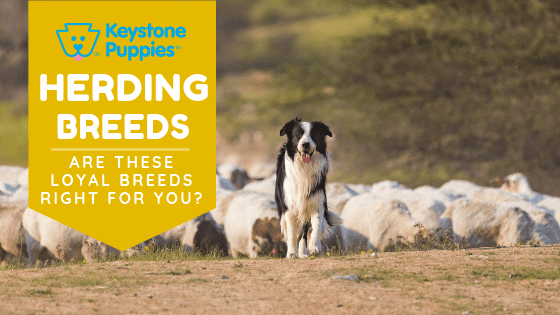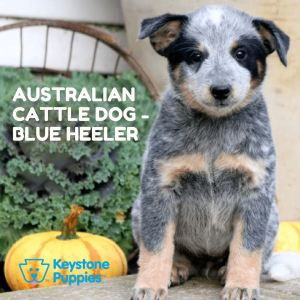Herding Breeds – Are They Right for You?

While many people know that herding dogs started out as helpmates for shepherds and farmers not everyone realizes that this group of pups is also extremely intelligent and agile. Even if you have a mixed breed, you may be able to identify a herding gene since these dogs like to round up or herd all types of other creatures, including children. Herders are also prone to nip at the heels of people and animals in attempts to control their movements.
Herders have an athletic build, lots of energy, and the type of hardy coats that allow them to work outdoors in rain, shine, sleet, or snow. Herding breeds are also exceptionally loyal, like to follow their master, protective of their family, and since they are very eager to please, they are usually easy to train.
The History of Herders
Dogs that guarded livestock, the predecessors to true herders, start showing up as early as 9,000 B.C. and are recognized as herding specialists around 4,000 B.C. Around 1600, references to shepherd dogs start appearing. While we may think of herding dogs as sprightly collies, in other parts of the word burlier herding breeds did double duty warding off wild animals. There have been different breeds of herding dogs in almost every country in the world for centuries, varying in size, speed, and talents. We’ll examine some of them here.
Herding Breeds
Akbash
The loyal Akbash Dog was bred to protect his family and his herd. These white herding dogs were bred to watch flocks without much supervision, and as a result are rather independent The Akbash is a Turkish breed that has been around for centuries but is still not recognized by the American Kennel Club. This high energy pup needs lots of outdoor exercise and is not a good choice for a docile companion dog.

Anatolian Shepherd
The Anatolian Shepherd is an ancient herding and guardian dog that has been around for more than 6,000 years. This ancient Turkish breed is exceptionally strong and fast and was bred to work independently. Because it needs lots of vigorous outdoor exercise, this breed is best for homes with large yards and active owners. The American Kennel Club recognized the Anatolian Shephard in 1999.

Australian Cattle Dog – Blue Heeler
The Australian Cattle Dog breed was developed in Australia to help herd cattle and sheep. Their lineage is complicated, and it’s believed they were developed from a mix of a Collie breed, Dalmatians, Bull Terriers, and wild Dingos. This robust breed needs daily vigorous exercise and is best suited for active owners with lots of outdoor space. The Blue Heeler was recognized by the American Kennel Club in 1980.

Australian Shepherd
The history of the Australian Shepherd is unclear. Versions of this dog probably existing in Spain and Australia, but they came into their own when they were shipped with Australian sheep to California during the Gold Rush in the 1850s. America claimed this breed as their own, and the breed became associated with cowboys in the West. The Australian Shepherd has become popular in recent years being used as therapy dogs, service dogs, and search and rescue dogs. This breed was recognized by the AKC in 1991.
Border Collie
The Border Collie was originally bred in Scotland but was developed as a popular breed in Australia. This highly intelligent and agile pup is not only an excellent herding dog, but it is also a loyal and protective family dog, and excellent with children. Like most herders, the Border Collie needs lots of vigorous exercise and is an enthusiastic barker. The Border Collie accepting into the AKC in 1995.

Cane Corso
The Cane Corso was bred to herd large livestock such as cattle and swine. Its strength, fierce appearance, and stamina also made it a popular choice for boar hunting and bear fighting. While almost extinct in the 1970s, this blue-eyed breed has bounced back. This gentle giant is loyal and loving to its family, but is also very protective of its owner, and is wary of strangers. While the Cane Corso needs lots of outdoor exercise, it is not quite as energetic as Australian Shepherds or Border Collies. This breed was recognized by the American Kennel Club in 2010.

Collie
The Collie is a Scottish dog bred for herding sheep in cold climates. Collies are still popular farm dogs that are loyal, eager to please, intelligent, and easy to train. Collies have strong herding instincts and may try to move children and other pets by chasing and nipping at heels. They love to bark, and like most herding dogs, they need lots of outdoor exercise to stay calm and centered. This breed was first registered by the American Kennel Club in 1885.

German Shepherd
The German Shepherd is one of the most popular breeds in the United States. This herder was first bred in Germany during the 1800’s as a working and herding dog, but its size, stance, and obedience made it a good choice as a military dog. German Shepherds have a long history as an American and European battlefield dog. Today, they are the most popular choice for American K-9 units and are often utilized for drug detection, and search and rescue. They are also often used as therapy and service dogs. These loyal pups also make gentle and obedient family pets, although they can be very protective of owners and wary of strangers. These dogs need daily exercise and don’t like to be left alone for long periods, but require less vigorous exercise than other herding breeds. The German Shepherd was recognized by the American Kennel Club in 1908.

Rottweiler
While Rottweilers sometimes have the reputation of being a fierce guard dog, Rottweilers are considered one of the oldest herding breeds. Historians believe that Rottweilers are descended from drover dogs used for herding by the Romans. These intelligent, loyal dogs have been used as guard dogs and police dogs, but they are also gentle and loyal with their family, and good with kids. They need moderate outdoor exercise but should be exercised daily. The Rottweiler breed was first recognized by the AKC in 1931.

Samoyed
This fluffy, white dog is famous for its “smile,” But this happy-looking pup is also a hard worker. The Samoyed breed was named after a Siberian tribe and was originally used to herd reindeer in the Arctic. This gentle breed is a good herder, but lacks hunting instincts, making it a gentle and loyal family pet. The Samoyed loves children and is a good barking watchdog, but lacks the aggression to be a guard dog. This breed needs daily outdoor exercise to stay calm and centered. The Samoyed was first registered by the American Kennel Club in 1906.

Shetland Sheepdog
The Shetland Sheepdog, or Sheltie, is named for the Shetland Islands off the coast of Scotland. Like the Collie, Australian Shepherd, and Border Collie, the Shetland Sheepdog is very intelligent, agile and loyal. They love children, but also like to chase and herd, sometimes nipping at heels. These puppies also need lots of vigorous outdoor exercise and are best for owners with large yards or lots of outdoor space. The Sheltie was first registered by the AKC in 1911.

Welsh Corgi – Pembroke
The Welsh Corgi can be traced back to the 1100s when they were bred for herding sheep and cattle. Although they are short, they are also very fast and agile, and herd by nipping. These stout companions love children and other dogs. They are intelligent, loyal, and eager to please, which makes them easy to train. They need a moderate amount of daily outdoor exercise and are less energetic than some other herding breeds. The Welsh Corgi-Pembroke breed was recognized by the American Kennel Club in 1934.

***
Herding breeds are intelligent, loyal, athletic, and agile. If you’re interested in bringing a herding breed into your home, remember their need for outdoor exercise. If you want to learn more about herding breeds and other types of puppies, research over 200 breeds of dogs by clicking here. If you already know what kind of puppy you want, get started here.







